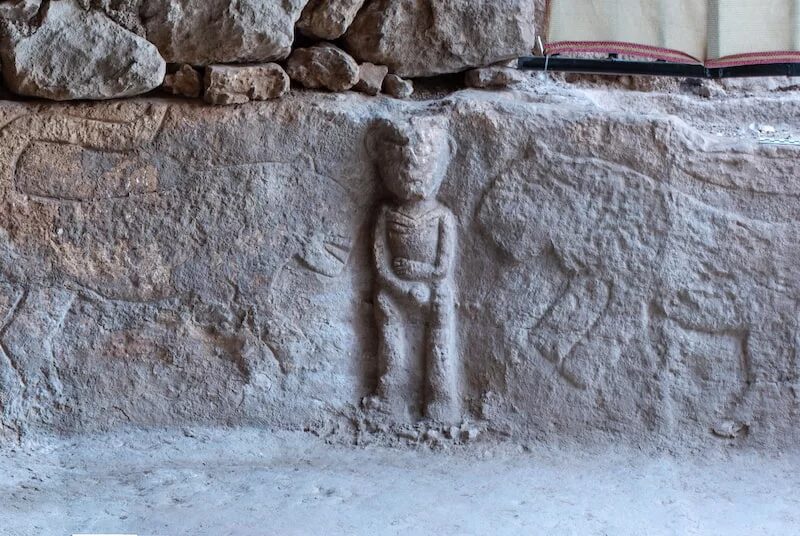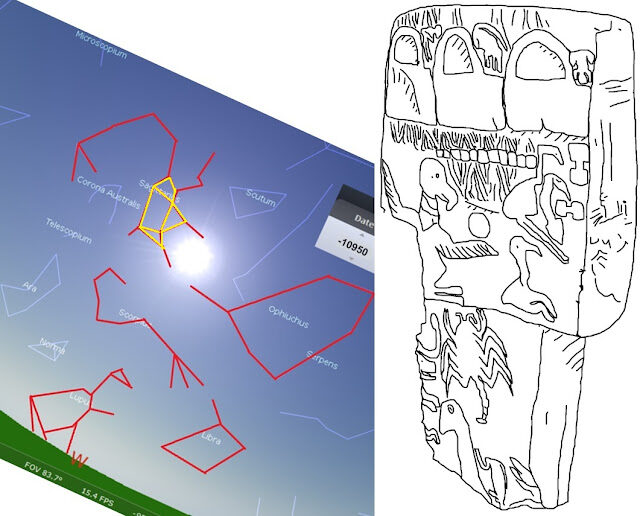There are numerous symbolic links between Catalhoyuk (Central Turkey, 7100-6000 BCE) and Gobekli Tepe (southern Turkey, ~10,000-8000 BCE) that show they knew the same (or similar) astronomical zodiacal system.

© PreHistory Decoded
First, see
here for a list of known 'Master/Mistress-of-Animals' symbols from around the Near Eastern region. Above is a 3rd millennium BCE example from Ur, Mesopotamia.

© PreHistory Decoded
We also have a Mistress-of-Animals, or
Potnia Theron, at Catalhoyuk (above). This shows symbolism from the 8th millennium BCE survived until the Bronze and Iron Ages.

© PreHistory Decoded
We now also have a Master-of-Animals at Sayburc, one of the
Tas Tepeler sites and only around 25 km from Gobekli Tepe (above). This suggests it is possible for symbolism to survive from the time of Gobekli Tepe through to the Bronze and Iron ages too.
Now consider that at Catalhoyuk, there were only four kinds of large wall installation in the lower levels, before around 6400 BCE, which were ursine (bear), bovine (bull), feline (leopard) and ovine (ram). These four kinds of shrine are described by the site's lead excavator, Ian Hodder, in his book "Catalhoyuk: the leopard's tale" (2011). This is exactly what we can expect for a religious system focussed on the solstices and equinoxes, with shrines dedicated to the respective zoomorphic constellations, as predicted by Gurshtein (2005). We also have evidence that the tower at Jericho was used to observe the summer solstice, circa 8000 BCE (
see previous blog post).

© PreHistory Decoded
Now consider Pillar 43 at Gobekli Tepe that highlights four other animal symbols, each next to symbols that are also known to symbolise the sun in later cultures, especially Egypt and Sumer. The circular disk is an obvious symbol for the sun, used in many places including Egypt.

© Encylcopedia Brittanica Online.
The semi-circles at the top of Pillar 43 are known to mean 'sun' and units of time in 4th millennium BCE Sumer. They are used together with animal symbols on various artefacts from the region which can be interpreted as providing zodiacal dates, including the one below from Jiroft (Iran) which also includes a Master-of-Animals symbol.

© PreHistory DecodedJiroft stone weight, 3rd millennium BCE.
At Catalhoyuk, one of the main wall installations was the bear-shrine. Originally, this symbol was thought to represent a goddess, but recent discoveries indicate they were bears instead. Below, far right, is a seal stamp from Catalhoyuk in the form of a bear. Next to it is a typical bear-shrine wall installation. Their faces are all damaged, making identification difficult. But given their similarity with the seal stamp, they can now be identified as bear shrines. They normally have circles on their bellies. These likely symbolise the summer solstice constellation. At this time, the constellation was Virgo, which is the summer solstice constellation from around 7300-4300 BCE.

© PreHistory Decoded
On the far-left above is a symbol from Pillar 43. It is likely the same symbol as the one next to it which was recovered from Gobekli Tepe and is now in Sanliurfa museum. Clearly, they are the same as the symbols from Catalhoyuk, indicating they symbolise the same constellation, similar to Virgo. At the time of the Younger Dryas impact, Virgo was the spring equinox constellation (but only just, the spring equinox constellation would soon become Leo). This means, if our hypothesis is correct, we expect to see this symbol at the top-right of Pillar 43. Of course, this is exactly where we find it. No other theory (to my knowledge) can explain this in a very simple way. That is, no other theory can easily explain why the same symbol appears at the top right of Pillar 43 next to a semi-circle symbol while it is also one of the main shrine symbols at Catalhoyuk, where it displays a circle on its belly.
Reader Comments